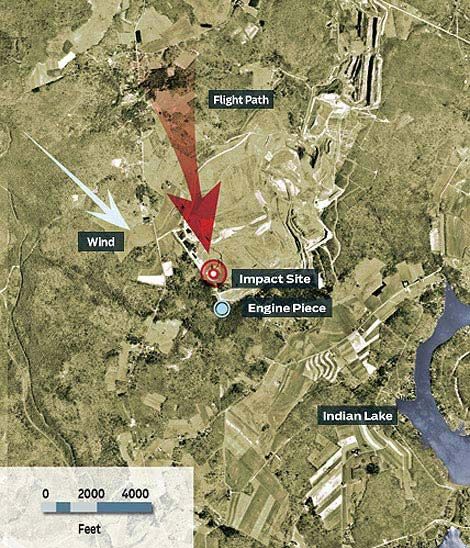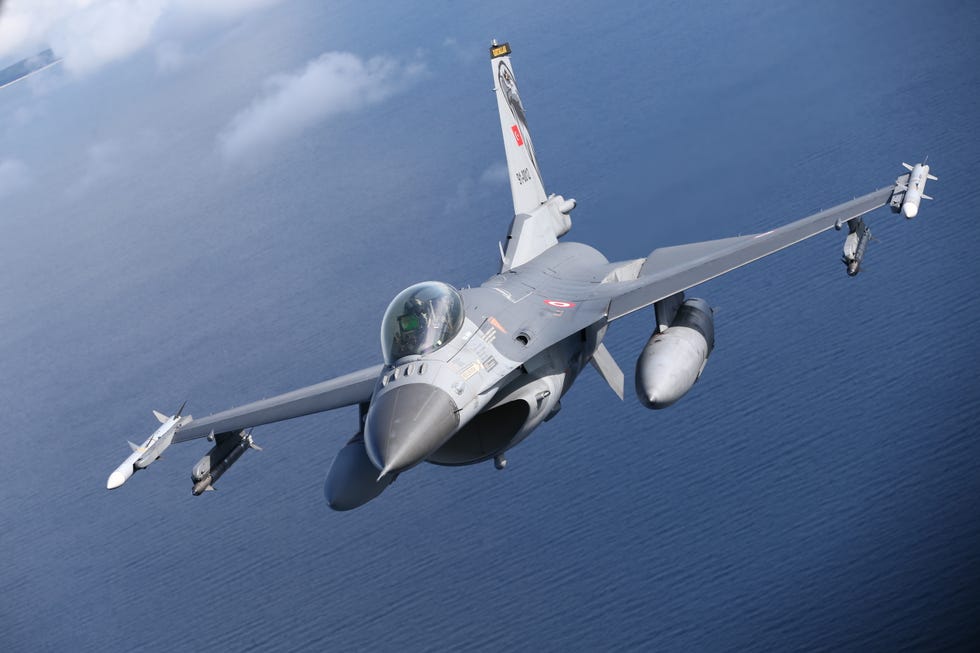We Debunked the 9/11 Myths About United Flight 93
September 2024: The Tower of Voices in Pennsylvania stands 93 feet tall in honor of United Flight 93, the plane that crashed on September 11, 2001, when passengers thwarted hijackers’ attempt to crash the plane into a building. The tower features 40 wind chimes for the 40 heroes who died that day.
In the two decades since the 9/11 attacks, the kinds of conspiracy theories that swirled around the World Trade Center attacks in Manhattan have touched the crash of Flight 93, too. Here, in Popular Mechanics’ debunking (originally published in 2005), we take on the myths about that fateful flight.
Cockpit recordings indicate the passengers on United Airlines Flight 93 teamed up to attack their hijackers, forcing down the plane near Shanksville, a township in southwestern Pennsylvania. But conspiracy theorists assert that Flight 93 was destroyed by a heat-seeking missile from an F-16 or a mysterious white plane.
Some conspiracy theorists add far-fetched elaborations: No terrorists were aboard, or the passengers were drugged. The wildest is the “bumble planes” theory, which holds that passengers from Flights 11, 175, and 77 were loaded onto Flight 93 so that the U.S. government could kill them.
The White Jet
CLAIM: At least six eyewitnesses say they saw a small, white jet flying low over the crash area almost immediately after Flight 93 went down. BlogD.com theorizes that the aircraft was downed by “either a missile fired from an Air Force jet, or via an electronic assault made by a U.S. Customs airplane reported to have been seen near the site minutes after Flight 93 crashed.”
WorldNetDaily.com also weighs in: “Witnesses to this low-flying jet … told their story to journalists. Shortly thereafter, the FBI began to attack the witnesses with perhaps the most inane disinformation ever—alleging the witnesses actually observed a private jet at 34,000 [feet]. The FBI says the jet was asked to come down to 5000 [feet] and try to find the crash site. This would require about 20 minutes to descend.”
FACT: There was such a jet in the vicinity—a Dassault Falcon 20 business jet owned by the VF Corp. of Greensboro, North Carolina, an apparel company that markets Wrangler jeans and other brands. The VF plane was flying into Johnstown-Cambria airport, 20 miles north of Shanksville. According to David Newell, VF’s director of aviation and travel, the FAA’s Cleveland Center contacted copilot Yates Gladwell when the Falcon was at an altitude “in the neighborhood of 3,000 to 4,000 feet.” Not 34,000 feet.
“They were in a descent already going into Johnstown,” Newell adds. “The FAA asked them to investigate and they did. They got down within 1,500 [feet] of the ground when they circled. They saw a hole in the ground with smoke coming out of it. They pinpointed the location and then continued on.” Gladwell confirmed this account, but, concerned about ongoing harassment by conspiracy theorists, asked not to be quoted directly.
Roving Engine
CLAIM: One of Flight 93’s engines was found “at a considerable distance from the crash site,” according to Lyle Szupinka, a state police officer on the scene who was quoted in the Pittsburgh Tribune-Review. Offering no evidence, a posting on Rense.com claimed: “The main body of the engine … was found miles away from the main wreckage site with damage comparable to that which a heat-seeking missile would do to an airliner.”
✅ Get the Facts: 9/11 Conspiracy Theories
FACT: Experts on the scene told Popular Mechanics that a fan from one of the engines was recovered in a catchment basin downhill from the crash site. Jeff Reinbold, the National Park Service representative responsible for the Flight 93 National Memorial, confirms the direction and distance from the crash site to the basin: just over 300 yards south, which means the fan landed in the direction the jet was traveling.
“It’s not unusual for an engine to move or tumble across the ground,” says Michael K. Hynes, an airline accident expert who investigated the crash of TWA Flight 800 out of New York City in 1996. “When you have very high velocities, 500 miles per hour or more,” Hynes says, “you are talking about 700 to 800 feet per second. For something to hit the ground with that kind of energy, it would only take a few seconds to bounce up and travel 300 yards.” Numerous crash analysts contacted by Popular Mechanics concur.
Indian Lake
CLAIM: “Residents and workers at businesses outside Shanksville, Somerset County, reported discovering clothing, books, papers, and what appeared to be human remains,” states a Pittsburgh Post-Gazette article dated September 13, 2001. “Others reported what appeared to be crash debris floating in Indian Lake, nearly six miles from the immediate crash scene.”
Commenting on reports that Indian Lake residents collected debris, ThinkAndAsk.com speculates: “On September 10, 2001, a strong cold front pushed through the area, and behind it—winds blew northerly. Since Flight 93 crashed west-southwest of Indian Lake, it was impossible for debris to fly perpendicular to wind direction. … The FBI lied.” And the significance of widespread debris? Theorists claim the plane was breaking up before it crashed. TheForbiddenKnowledge.com states bluntly: “Without a doubt, Flight 93 was shot down.”
FACT: Wallace Miller, Somerset County coroner, says that no body parts were found in Indian Lake. Human remains were confined to a 70-acre area directly surrounding the crash site. Paper and tiny scraps of sheetmetal, however, did land in the lake.
“Very light debris will fly into the air, because of the concussion,” says former National Transportation Safety Board investigator Matthew McCormick. Indian Lake is less than 1.5 miles southeast of the impact crater—not six miles—easily within range of debris blasted skyward by the heat of the explosion from the crash. And the wind that day was northwesterly, at nine to 12 mph, which means it was blowing from the northwest—toward Indian Lake.
F-16 Pilot
CLAIM: In February 2004, retired Army Col. Donn de Grand-Pre said on “The Alex Jones Show,” a radio talk show broadcast on 42 stations: “It [Flight 93] was taken out by the North Dakota Air Guard. I know the pilot who fired those two missiles to take down 93.” LetsRoll911.org, citing de Grand-Pre, identifies the pilot: “Major Rick Gibney fired two Sidewinder missiles at the aircraft and destroyed it in mid-flight at precisely 0958.”
FACT: Saying he was reluctant to fuel debate by responding to unsubstantiated charges, Gibney (a lieutenant colonel, not a major) declined to comment.
According to Air National Guard spokesman Master Sgt. David Somdahl, Gibney flew an F-16 that morning—but nowhere near Shanksville. He took off from Fargo, North Dakota, and flew to Bozeman, Montana, to pick up Ed Jacoby Jr., the director of the New York State Emergency Management Office. Gibney then flew Jacoby from Montana to Albany, New York, so that Jacoby could coordinate 17,000 rescue workers engaged in the state’s response to 9/11.
Jacoby confirms the day’s events. “I was in Big Sky for an emergency managers meeting. Someone called to say an F-16 was landing in Bozeman. From there we flew to Albany.”
Jacoby is outraged by the claim that Gibney shot down Flight 93. “I summarily dismiss that because Lt. Col. Gibney was with me at that time. It disgusts me to see this because the public is being misled. More than anything else, it disgusts me because it brings up fears. It brings up hopes—it brings up all sorts of feelings, not only to the victims’ families but to all the individuals throughout the country, and the world for that matter. I get angry at the misinformation out there.”
Reporting: Benjamin Chertoff, Davin Coburn, Michael Connery, David Enders, Kevin Haynes, Kristin Roth, Tracy Saelinger, Erik Sofge and the editors of Popular Mechanics.
Photography Research: Sarah Shatz.





